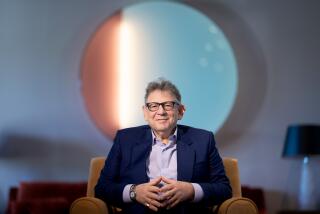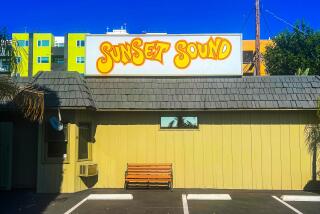A simple formula to put young musicians on CD
Orion Weiss is an up-and-coming pianist who has appeared with the Los Angeles Philharmonic as well as orchestras in Baltimore, Indianapolis and Minnesota. He’s given solo recitals in New York, St. Louis and Paris. But for all that, Weiss, 25, has a problem he shares with many of his musical peers: how to be heard on a professionally made CD.
“There are not many labels doing serious, dedicated recordings of young artists,” Weiss said recently. “A lot of musicians are recording over and over, but there are not that many opportunities for young artists.”
Enter Bob Attiyeh, a Los Angeles recording engineer and the impresario behind Yarlung Records, a nonprofit “audiophile” label dedicated to giving breaks to musicians such as Weiss.
Yarlung has issued the first two CDs by 24-year-old Australian pianist and Colburn Conservatory graduate David Fung and the debut album of the Janaki String Trio, an ensemble that got its start at the conservatory in 2005. The label’s fourth disc -- by Weiss -- is due by year end. And eventually Attiyeh hopes to release six to eight debut albums annually.
If Attiyeh’s name has a familiar ring, that’s because his father, also named Bob, is a former Philharmonic board member and onetime chief financial officer of the biotechnology company Amgen.
“We get confused all the time,” said the younger Attiyeh, who for the record is Robert J.S., whereas his father is Robert S.
Attiyeh, 43, began his career in 1994 making field recordings for the Tibetan Institute of Performing Arts in Dharamsala, India, home of the Tibetan government in exile. He had gone to Tibet itself in 1987 when he was 23, just after graduating from Princeton.
“No, I was not seeking enlightenment,” he said. “It was a fairly long trip, and Tibet was only part of it. But it was a very fresh experience, that visit.”
The thought of returning to the Himalayan nation nagged him for several years as he worked in marketing and development at Los Angeles Opera. And when he finally went to Dharamsala, he took some battery-operated recording equipment because “the power is not on all the time.”
“Those were very fun sessions and some of my best,” he said. “I did a recording in the Nechung Monastery that includes the long horns. You can even hear dogs barking at night outside the monastery. At the institute itself, our greatest challenge was monkeys who were on the roof and banged on it occasionally to show their pleasure or displeasure, I can’t tell which.”
Through those recordings, Attiyeh also began his foray into the audiophile world.
“The audiophile field is a very strange breed who listen to music very differently than most people do,” he said. “I became first an avid listener as an audiophile, then became very interested in how the very finest recordings were made.”
That led him to working with veteran recording engineers such as Steve Hoffman, Gustavo Hidalgo and Elliot Midwood. (Hidalgo died last year in Santa Monica. Attiyeh dedicated one of Fung’s CDs to his memory.) Today, Hoffman and Midwood assist with Yarlung.
A year after he founded the label in 2005, Attiyeh created the nonprofit organization Yarlung Artists to raise money to support his musicians, who have been recommended by advisors such as conductor Harry Bicket and Curtis Institute of Music President Roberto Díaz.
Both parts of the enterprise are named after the Yarlung Valley in central Tibet, “where heaven and earth touched momentarily, symbolically, and spawned the Tibetan people and culture,” Attiyeh said. “To me, there is something about this union of divine and human realms, something that speaks to me very much about what music actually means.”
The concept of an audiophile recording is simple, he said: “First you find an extraordinary musician who can play a great instrument. Then you find a fabulous acoustic space. Finally, you do as little as possible after that, meaning the equipment is minimal.”
Yarlung records everything on two tracks and uses no mixers. “Mixers add enormous noise, distortion and make it very difficult to create an accurate sound stage,” Attiyeh said. “I will say that there are geniuses in the recording world who can create fabulous sound stages from multiple-miked recordings. But they’re rare. They’re very special. They walk on water, these people.”
“The golden age of music recording -- RCA Living Stereo, Mercury Living Presence -- all used this minimalist miking technique,” said Hoffman, Yarlung’s mastering engineer and one of the engineers Attiyeh feels walks on water. “Less microphones equals less phase problems, less cross-talk, less amplified noise. Pure sound. When you’re in an audience, you’re not listening through 18 ears but two. It just stands to reason if you record pure music like that, you’re going to reproduce that event.”
So why did the method go out of fashion?
“Engineers like to screw around,” Hoffman said. “Even the original engineers in the 1950s who invented that process fell prey to the all-powerful idea of a remix. You get this stuff down on 16 tracks, then screw around to your heart’s content. Bob feels the performer creates the performance, not the engineer, and he can get it live.”
Attiyeh produces his CDs on a shoestring budget of approximately $20,000 to $25,000 a disc.
“The reason the price is so low is that we get a lot of help,” he said. For one thing, the Colburn School provided its Herbert Zipper Concert Hall for the recordings of its graduates. And Hoffman, who commands high fees for his commercial work, works pro bono.
“It’s strictly a labor of love,” Hoffman said. “I just had an instant rapport with Bob. I really related to what he was trying to do. I admire his idea of profit not necessarily being the sole motive in the music industry.”
The Yarlung artists are happy with the results.
“As soon as I heard what he was getting on the microphone, I was so thrilled,” Weiss said. “He was going for a beautiful but not pretty piano sound -- a rich and beautiful and complex piano sound, not something with too music reverb or too much muddiness.”
Fung was equally enthusiastic. “Bob’s process is very direct and captures the purity and direct nature of the sound,” he said. “He’s really been a friend too, not somebody just sitting behind the microphones. He listens to the person, and he’s a huge supporter of where the music goes.”
Attiyeh expects his production budget to remain small, but ideally he would like to spend $25,000 promoting each disc.
“All of that additional money will go toward publicity and the visibility of the musicians,” he said. “That is the goal -- so that we can do a better job promoting them to conductors and to orchestras around the world so that they can hire them.
“Our mission as a nonprofit is to create a debut album with the hope that this will launch the musicians’ careers on the concert stage and also attract a major label which will continue to record with them.
“Fifteen years from now, I hope to look around the world and see 100 successful concert artists where we have played some part in their early success. This is more important to me personally than having a large record catalog. That’s what we’re about.”
--
More to Read
The biggest entertainment stories
Get our big stories about Hollywood, film, television, music, arts, culture and more right in your inbox as soon as they publish.
You may occasionally receive promotional content from the Los Angeles Times.










